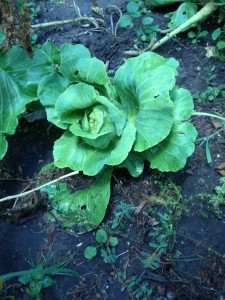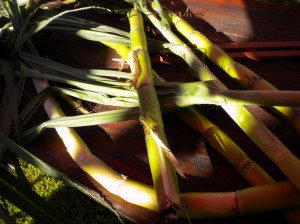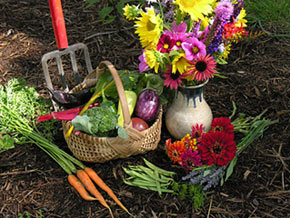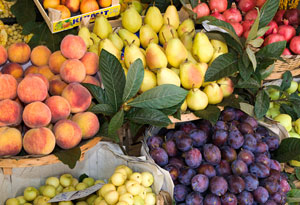Bamboo:
Depending on who you ask, bamboo is the new, eco-friendly product of the season. Used to make everything from blankets to shoes to flooring, bamboo is a versatile and, more importantly, fast-growing and replenishable plant.
Biodegradable:
The ability of a material to decompose through natural processes and eventually be reabsorbed by the natural environment. Biodegradable products include all plant and animal material, paper, food waste and fibers. Plastic, glass and metals are not biodegradable. However, even biodegradable materials will not break down once they are buried in a landfill because they are deprived of oxygen, which is necessary for decomposition. Composting provides optimal conditions for biodegradation. The “Biodegradable” label on products like cosmetics, cleaning supplies, packaging or household items is not necessarily reliable because it is not verified and follows no uniform standards.
Conflict-Free Diamonds:
Diamonds produced without the involvement of violence, human rights violations or environmental degradation. The Conflict-Free Diamond Council examines the entire supply chain—from mine to consumer—before certifying that a diamond is conflict-free.
Cork:
It may come as a surprise to wine aficionados, but cork is able to do more than keep bottles sealed tight. Found in Ugg boots, floor tiles, jewelry and everything in between, cork is fully recyclable, flexible and repels water.
Eco-friendly:
Also known as “environmentally friendly” or “nature-friendly,” eco-friendly refers to goods and services that inflict minimal harm on the environment.
Fair Labor:
A code of conduct by which participating companies—mostly in the clothing and shoe industries—agree to provide factory workers with fair wages, reasonable work hours, the right to collective bargaining, a safe and healthy workplace free from abuse and discrimination and fair overtime compensation. Forced and child labor are not allowed.
Fair Trade:
Crops produced according to principles in which poor farmers in developing countries receive fair prices for their products, workers enjoy safe working conditions and fair wages, communities receive development assistance and investment in social programs and crops are grown with sustainable farming methods and without the use of pesticides or genetically modified organisms. Products labeled as “Fair Trade Certified” are verified and audited by an independent certifier. Fair Trade Certification is currently available in the United States for coffee, tea and herbs, cocoa and chocolate, fresh fruit, sugar, rice and vanilla.
Green:
The adjective used to describe people, behaviors, products, policies, standards, processes, places, movements or ideas that promote, protect, restore or minimize damage to the environment.
Hemp:
Long a favorite accessory and jewelry piece, hemp is one of the most versatile fibers available. Hemp can now be found in books and paper products, bags, pet supplies, face creams and flour and has long outgrown its hippy roots.
Natural:
Purely defined, natural means anything found in nature or derived directly from plants, animals or minerals. Natural products do not contain any man-made (synthetic) ingredients. On food, “Natural” or “All Natural” labels are not meaningful because the federal standard is weak. The USDA will allow a product to be labeled “natural” if it is free from artificial ingredients, added coloring and heavy processing. Natural does not mean organic.
Natural dyes:
Sometimes known as “organic” dyes, natural dyes come from natural sources. These dyes are different than man-made, synthetic dyes—which, to confuse matters, can also be organic—that often use toxic, non-natural sources and ingredients. Natural dyes typically cost more than synthetic dyes but are generally considered more eco-friendly overall.
Organic fabrics and textiles:
Plant and animal fibers like cotton, wool, hemp, linen, cashmere, silk, jute, soy and bamboo can be certified organic if they are produced according to organic standards set by the USDA. However, the organic label does not guarantee that the finished fabric or textile product is free of synthetic chemicals, bleaches or heavy dyes. The Organic Trade Association certifies finished textiles and garments in the United States.
Organic meat, dairy, poultry, eggs and other livestock products:
Organic animal products come from livestock that are fed organic feed and forage throughout their lives, beginning in at least the last third of gestation before birth. Synthetic hormones, antibiotics, chemicals and genetic engineering are prohibited. The living environment must be stress-free and promote the health and well-being of the animals, as well as prevent the contamination of air, land and water. For a livestock product sold in the United States to be labeled organic, it must meet USDA standards and be certified by third-party accredited inspectors.
Organic produce:
Fruits, vegetables, grains, nuts, lentils, etc. produced without the use of synthetic fertilizers or pesticides and with farming techniques that protect soil quality, minimize erosion and actively prevent the contamination of air, land and water. For an agricultural product sold in the United States to be labeled organic, it must meet U.S. Department of Agriculture standards and be certified by third-party accredited inspectors.
Ovo-lacto vegetarian:
A diet, recipe or product that involves no meat, poultry or seafood, yet may contain eggs, dairy products, honey, gelatin or other animal-derived ingredient. Followers of this diet are often considered vegetarians.
Pesticide-free:
Plants or crops grown without the use of chemical pesticides for controlling weeds, insects, slugs, grubs or rodents. This label is not equivalent to organic and is not verified by an independent or government standard.
Reclaimed:
Materials destined for the garbage dump but were, instead, rescued and refurbished as a new product. The floor of an old bowling alley can be reclaimed and turned into a dining room table, or bricks from a demolished structure can be used to build a fireplace hearth. The use of glass shards in ceramic tiles is another example of the use of reclaimed material.
Recycled:
Materials that have been taken from one product and made into a new product. The recycling process generally saves energy and reduces the need to extract additional raw resources from the earth. The most commonly recycled products in the United States include paper, glass, steel and aluminum, all of which can be reincarnated as the products they were recycled from. Plastic is also recyclable, but it goes through a process known as downcycling. When a plastic water bottle is broken down for recycling, the quality of the plastic material is diminished, and it is no longer fit to become another water bottle. Instead, it may become filler for a fleece jacket, carpet fibers or a park bench. Packages with Post-Consumer Recycled Content are made from materials that were recycled instead of being sent to a landfill.
Renewable:
Resources that can be replenished quickly after use so that they are not permanently diminished or depleted. Renewable energy sources include the sun (solar power), wind, flowing water and geothermal heat. Renewable material resources include algae, grasses and some fast-growing trees. Substituting renewable resources for nonrenewable resources (e.g., coal, oil, gasoline and other fossil fuels) is the key to sustainability.
Sustainability:
Meeting the needs of the present without diminishing the ability of future generations to meet their needs. Sustainability also means that human practices do not result in the permanent damage, alteration or depletion of the environment, ecosystems, species or natural resources.
Scrap fabrics:
Using scrap fabrics is considered more eco-friendly than manufacturing new products and is often called “reuse”. Scrap fabrics have more uses than quilts and costumes, however: Cirque de Soleil uses scraps from its costumes and tents to fill Christmas ornaments, while Goodwill recently released a high-end line of clothes based on “scrap” clothes called William Good. As they say, one man’s scrap is another man’s treasure.
Soy:
The soybean is the food staple of choice for many vegetarians and those with lactose intolerance due to its high protein levels. Soy is useful beyond food, however, and soybean fiber can be used to make everything from baby clothes to sweaters.
Synthetic:
Materials that do not occur naturally but rather are produced artificially through chemical processing. Most synthetic products (plastic, nylon, polyester, polystyrene, etc.) are made from petroleum byproducts, while synthetic components of food, personal care products and pharmaceuticals are produced with chemicals in a laboratory.
Tencel:
Tencel is, in fact, the commercial name for lyocell, a product made by the Lenzing AG as polyester, as easy to care for as acrylic, cool and pleasant like linen, as warm as wool and absorbs more moisture than cotton.” It uses no bleach to manufacture and is fully biodegradable but has come under some criticism for using toxic chemicals in the dyeing process.
“USDA Organic” (label):
Product contains at least 95 percent certified organic ingredients. The remaining 5 percent can be nonorganic or synthetic, as long as they are approved on the national list (http://www.ams.usda.gov/nop/NOP/standards/ListReg.html).
“USDA Made with Organic Ingredients” (label):
Product contains at least 70 percent organic ingredients. The remaining 30 percent must be approved on the national list.
“USDA 100 Percent Organic” (label):
Product contains only organic ingredients.
Vegan lifestyle:
A way of living that avoids products containing animal products or byproducts, involved testing on animals or in any way resulted in animal harm. True vegans do not eat products containing meat, poultry, seafood, dairy, eggs, gelatin (derived from hooves), whey, honey or refined sugar (often refined using animal bones). Vegans do not buy or use products (such as clothes, accessories, cosmetics or cleaning products) made with leather, wool, cashmere, silk, suede, fur, animal fats (e.g., lanolin) or any other animal-derived ingredient.
Vegan products:
Products produced without animal ingredients (meat, fur, leather, bones, etc.), animal byproducts (milk, eggs, wool) or animal testing. In many cases, vegan products contain synthetic components, which may be harmful to the environment. Vegan products such as food, cleaning products, clothing and personal care may be certified by an independent organization, but there are no federal standards set for vegan certification.
By: Elizabeth Rogers, Environmentalist –provides definitions of the most common green-related terms.




 A Natural Way to Garden Organic
A Natural Way to Garden Organic  As the recession lingers on, food writer Nina Planck tackles this controversial question.
As the recession lingers on, food writer Nina Planck tackles this controversial question.